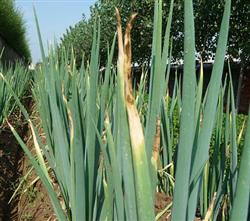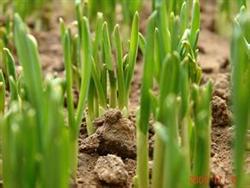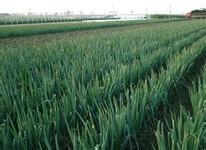Fertilization techniques for High quality and High yield of Welsh Onion

If Welsh onion cultivation wants good quality and high yield, it is the key to reduce nitrogen and increase potassium in fertilization. The specific fertilization methods are introduced as follows: 1. Welsh onion is a lily crop with a long growth period. in the Huang-Huai River Basin, it is generally adopted to raise seedlings from September to October, transfer from February to March of the following year, harvest scallion or shallot from May to June, or raise seedlings from March to April, transplant in June, and harvest large white onions in autumn and winter. The yield of Welsh onion is relatively high, generally 667 square meters (1 mu) has a yield of 3000 to 6000 kg, and the ratio of absorption of nitrogen, phosphorus and potassium is about 1 ∶ 0.4 ∶ 1.3.The demand for potassium and nitrogen is more, but phosphorus is less, so the proportion of fertilization should pay attention to the balanced supply of potash fertilizer, especially in high-yield cultivation and without organic fertilizer. The specific proportion of nitrogen, phosphorus and potassium fertilizer application mainly depends on the following three aspects: one is the potassium supply capacity of the soil itself. For example, if the potassium supply capacity of sandy soil is low, it is necessary to appropriately increase the amount of potassium fertilizer used. The second is the target output of green onions. Under the condition of high-yield cultivation, the amount of potassium taken away from the soil by Welsh onion per season is also more, so the application rate of potassium fertilizer should be increased accordingly. The third is the amount of other fertilizers, such as the amount of straw returned to the field, the amount of nitrogen fertilizer. If you put in a large amount of organic fertilizer, you can apply less potash fertilizer. In particular, the amount of chemical nitrogen fertilizer should be appropriate and balanced with the corresponding potassium fertilizer in order to have a good yield-increasing effect. Otherwise, the blind application of chemical nitrogen fertilizer is not only not beneficial to the high yield of green onions, but also leads to the decline of the quality of green onions, such as small proportion of green onions, many leaves, not strong onion flavor, even bitter taste and so on. two。 General green onion at a higher yield level, the recommended amount of nitrogen fertilizer is about 667 square meters of pure nitrogen 20 kilograms. The excessive application of nitrogen fertilizer, coupled with a large amount of water, not only wastes nitrogen fertilizer and increases the cost, but also produces green onions that are not resistant to storage and decline in quality, and will have a negative effect on the environment because of nitrogen loss. Therefore, the amount of nitrogen fertilizer should be appropriate, in the selection of nitrogen fertilizer varieties, the most common is urea, but the most suitable nitrogen fertilizer variety is ammonium sulfate, because green onions are sulfur-loving crops. 3. The method of fertilization is exquisite. The whole fertilization of green onion is divided into two parts: base fertilizer and topdressing fertilizer. The best base fertilizer is 667 square meters, 4000,000 kilograms of mature high-quality organic fertilizer, spread during soil preparation, and ploughed into the soil; chemical fertilizer base fertilizer should be applied to all phosphate fertilizer, 40% nitrogen fertilizer and 60% potassium sulfate fertilizer, varieties can choose compound fertilizer or elemental fertilizer. When selecting compound fertilizer, sulfur-based general type or special type can be selected, and high nitrogen compound fertilizer should not be applied. The application depth of the base fertilizer must be about 15 cm. The topdressing of green onion can be carried out in 2 to 3 times, and the remaining 60% nitrogen fertilizer and 40% potassium fertilizer will be applied as topdressing in the full leaf stage and the early and middle stage of onion white formation stage, respectively. The method of topdressing: it requires that the effect of water and fertilizer is good, and do not apply water and nitrogen, otherwise, it will not only cause low fertilizer utilization, but also spread urea on the surface in summer, and nitrogen volatilization will also cause fumigated leaves to burn seedlings.
- Prev

Seedling raising technique of Welsh Onion
First, the variety selection mainly includes star F1, Yuanzang, Changbao, Hanchun F1 and other Japanese imported varieties; domestic varieties: rare jade giant onion, iron pole, Moyu giant onion, Zhangqiu green onion and so on. Second, the sowing date and seedling age should choose loose and fertile land with high organic quality. Because green onions avoid continuous cropping, the previous crop has been planted with onions and garlic.
- Next

Pollution-free Control techniques of insect pests in Welsh Onion Field
First, onion thrips, also known as small white insects, smoke thrips. Adults and nymphs suck the sap in the leaves with file-sucking mouthparts, which make the onion leaves form many fine long yellow and white spots. In severe cases, the leaves turn yellow and white, twist, wither and droop, which seriously affects the yield and quality of green onions. 1. Occurrence regularity. The onion thistle is complete.
Related
- Where is it suitable to grow horseradish in China? it is expected to see the middle altitude horseradish in Alishan.
- How to prevent tomato virus disease reasonably? (Control methods included)
- Many people like to plant towel gourd on the balcony. What are the main points of this method and management?
- What crops can chili peppers be mixed with?
- Fertilization techniques and matters needing attention in Tomato
- What are the grafting techniques for peach seedlings in spring?
- Harm and control methods of root swelling disease of Chinese cabbage
- What are the pests of sweet potatoes? How to prevent and cure it?
- Symptoms, causes and Control methods of navel Rot in Tomato
- The cause of "Cucumber rotten bibcock" in Farmers' planting Cucumber and its Control Plan

